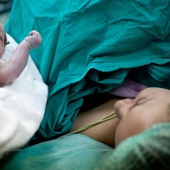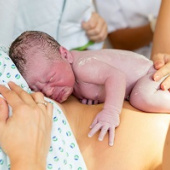What are your birth options for next time after a caesarean? Here we discuss the benefits and risks of a planned vaginal or elective caesarean birth.
What are my birth options after a caesarean birth?
You have two options for future births:
1. Plan for a vaginal birth after caesarean section (VBAC). VBAC is a safe choice for most women who have had a previous caesarean section (RCOG, 2016).
2. Plan an elective repeat caesarean section (ERCS). For some women, a repeat caesarean birth will be recommended for medical reasons. Some women might choose to opt for a caesarean section for physical or emotional reasons (RCOG, 2016).
Will a VBAC be successful?
- Most women who have had a caesarean section previously go into labour naturally and give birth vaginally to their next baby.
- Whether you can plan for a VBAC will depend partly on the reasons for your previous caesarean and any medical conditions you or your baby might have.
- If problems occur during labour, you might be advised to have a caesarean section due to the risk of complications from previous scarring.
- Some planned VBACs result in an emergency caesarean but most do not. (RCOG, 2016; NHS Choices, 2016)
What are the benefits and risks of a VBAC?
Benefits of a VBAC:
- A potentially quicker and easier recovery with a shorter hospital stay.
- Avoiding the risks of an operation.
- A greater chance of a vaginal birth for future pregnancies.
- A lower risk of initial breathing problems for your baby.
- You’re more likely to have skin-to-skin contact with your baby straight after they’re born and to be able to breastfeed them.
(RCOG, 2016)
Risks of a VBAC:
- There is a small risk of uterine rupture (one in 200 women), which increases by two to three times if you have labour induced.
- Around 25% of women attempting a VBAC will need an emergency caesarean.
- A slightly increased risk of needing a blood transfusion.
- The risk of serious injury to the baby, such as a brain injury or stillbirth, is higher than for a planned caesarean section. (The risk is the same as that for first-time labour.)
- You might need ventouse or forceps assistance or you might tear during a vaginal birth, but these risks are not specific to VBAC.
(RCOG, 2016)
What are the benefits and risks of an ERCS?
Benefits of an ERCS:
- Minimising the risk of uterine scar rupture.
- Avoiding rare, serious risks to the baby (two in 1,000).
- Having more certainty of your baby’s birth date.
(RCOG, 2016)
Risks of an ERCS:
- A repeat caesarean is usually longer and more difficult than a first because of scar tissue.
- A planned caesarean for future births becomes more likely. This is because more scar tissue occurs with each caesarean section, increasing the risk of placental problems.
- All serious risks increase with the number of caesareans.
- There are general risks associated with caesarean birth, which are not specific to ERCS. This includes the possibility a wound infection, blood clots, or needing a blood transfusion.
- A longer recovery time after a caesarean than a vaginal birth, like not being able to drive for up to six weeks.
- A small risk of the baby being cut during the surgery (two in 100 women)
- A small risk of the baby experiencing breathing problems. Four to five in 100 babies born by caesarean versus two to three in 100 following VBAC have breathing problems.
(RCOG, 2016)
It can be hard to decide what to plan for future births after having a caesarean birth. It’s a good idea to talk to your partner about your options. You can also discuss any medical questions or concerns with your midwife, health visitor or GP.
You might also find it helpful to read our articles on planning a VBAC and planning an ERCS, to help you decide.
This page was last reviewed in June 2018
Further information
Our support line offers practical and emotional support with feeding your baby and general enquiries for parents, members and volunteers: 0300 330 0700.
We also offer antenatal courses which are a great way to find out more about birth, labour and life with a new baby.
Make friends with other parents-to-be and new parents in your local area for support and friendship by seeing what NCT activities are happening nearby.
NHS Choices. (2016a) Caesarean section: Risks. Available from: https://www.nhs.uk/conditions/caesarean-section/risks/ [Last accessed 8 June 2018].
NHS Choices. (2016b) Caesarean section: Overview. Available from: https://www.nhs.uk/conditions/caesarean-section/#future-pregnancies-aft…. [Last accessed 8 June 2018].
NICE. (2013). Caesarean section: Quality standard [QS32]. Available from: https://www.nice.org.uk/guidance/qs32/chapter/quality-statement-1-vagin…. [Last accessed 8 June 2018].
RCOG. (2011) Information for you: A low-lying placenta (placenta praevia) after 20 weeks. Available from: https://www.rcog.org.uk/globalassets/documents/patients/patient-informa… [Last accessed 17 June 2018].
RCOG. (2015a) Information for you: Choosing to have a caesarean section. Available from: https://www.rcog.org.uk/globalassets/documents/patients/patient-informa…. [Last accessed 8 June 2018].
RCOG. (2015b) Birth after previous caesarean birth. Royal College of Obstetricians and Gynaecologists, Green-top guideline, 45. Available from: https://www.rcog.org.uk/globalassets/documents/guidelines/gtg_45.pdf [Last accessed 8 June 2018].
Further reading
Caesarean Birth and VBAC Information. (2004) Frequently asked questions about caesareans and VBAC. Available from: http://www.caesarean.org.uk/FAQ.html. [Last accessed 8 June 2018].
Knight M, Ancosta C, Brocklehurst P, Cheshire A, Fitzpatrick K, Hinton L, Jokinen M, Kemp B, Kurinczuk JJ, Lewis G, Lindquist A, Locock L, Nair M, Patel N, Quigley M, Ridge D, Rivero-Arias O, Sellers S, Shah A. (2016) Beyond maternal death: Improving the quality of maternal care through national studies of near-miss maternal morbidity. Programme Grants For Applied Research 4:(9). Available from: https://www.ncbi.nlm.nih.gov/pubmed/27386616 [Last accessed 8 June 2018]
Lavender T, Hofmeyr GJ, Neilson JP, Kingdon C, Gyte GM. (2012) Caesarean section for non-medical reasons at term. Cochrane Database Syst Rev. (3):CD004660. Available from: http://www.cochrane.org/CD004660/PREG_caesarean-section-for-non-medical…. [Last accessed 8 June 2018].






